Throughout the history of cinema the point of view we see through a camera lens is all very finely detailed in pre-production through the use of story-boarding and screenplays. It is an art where a masterpiece has been put together from carefully constructed shots used to establish and push forward both the narrative and the plot with the use of framing so we can visually see the story taking place. If you are an avid film lover you will most likely been witness to many of these shots from the standard close up to the Overhead establishing shots. It is very important to get your shots right as well. Not only do different shot types allow for emotion and symbolism. You’ll even find that some shots work better than others for different genres, for an intense drama there will be many close ups and medium shots to try and capture the emotion of the actors while a fantasy epic or war film will often feature wide shots or extreme long shots to give the perspective of such events like a battlefield. Any sort of high quality digital video production will be handcrafted and put together using shots, angles, and through moving the camera. Everything on screen is there to serve a purpose and is placed with meaning.
In this entry we’ll be looking in-depth at many of the shots used in cinema and television but we’ll also be looking into the very subliminal meanings found within the frames of some amazing films.
Extreme Long Shot (ELS) & Very Wide Shot (VWS)
Here we look at the Extreme Long Shot and the Very Wide Shot. These two shots are relatively the same and can be used in various ways. Firstly and primarily the Extreme long shot is often used as an establishing shot. It found itself being used in many genres of films because it could be used to capture vast amounts of information that would be useful to the audience. It allows to viewer to grasp the scale of where the story is taking place. It has other uses as well. It can be used to generate tension as well. For instance it could capture a densely packed street in the slums where anything can happen, or an approaching army numbering the thousands.

For our example of this kind of camera shot in action and its use in creating tension we’ll be looking at Denis Villeneuve’s ‘Sicario’ and more importantly its best scene. The border crossing scene between El Paso and Juárez.
The protagonists are basically going into Juarez to pick up a cartel leader from prison, and we are told over and over again that if there is going to be an attempt from the cartel to take him it’ll be at the border crossing. After a thirteen minute sequence of going in and coming back to the border crossing we are constantly on the edge of our seats however the police have done their best to make sure that we way is clear for the convoy. That is until the convoy hits this traffic jam right where we are told that an attack mostly likely will happen. To take it up to eleven the convoy becomes unable to move and there are threats from every side. If this were filmed using close ups and medium shots it wouldn’t have the same effect. As an audience we won’t be feeling of tension just as much, but the aerial extreme long shots throughout this scene make it one of the most intense moments to come out in the cinema in the last few years. In fact this whole scene is a monument of wonderful shots and brilliant cinematography.
Cinefix on YouTube created a video breaking down the individual elements within this sequence and it is most certainly worth a watch;
Notable Mention – Sound of Music
Sound of Music deserves a notable mention not just for its for the extreme wide shot but also because it fused to being an aerial shot back in the 70s. The whole frame radiates beauty.
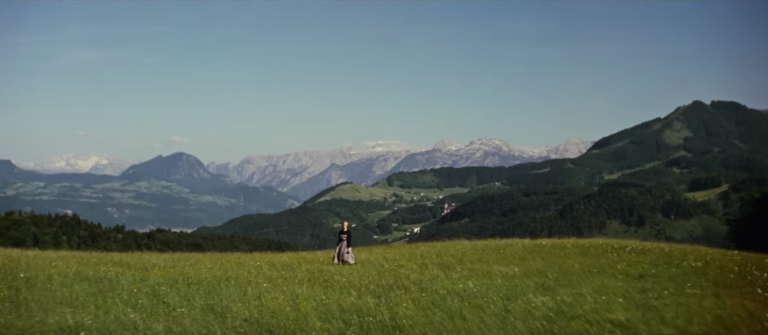
Long Shot (LS) & Wide Shot (WS)
The Long shot allows us to take in the whole surroundings of a character with them in it. Mostly we’ll see the whole body of the actor in question but we’ll also pick up additional pieces of information within the frame. Here we can get more of a sense of the characters themselves and not just as an establishing shot. In some cases the Extreme Long Shot could express emotion like the loneliness of mad max in a desert. So for this kind of shot, we should look at the opening of Once Upon a Time in the West.

Not only is the opening sequence fantastic by any regard. It is layered with amazing shots back to back with not a word said. The strength of this scene clearly is on the visuals. When the actors get to talking later on, their words hold more weight as we have spent precious seconds ramping up and feeling the station the outlaws are in. The use of Long and Wide Shots throughout this opening allow for the audience to feel out every nook and cranny of the wasting train station and feel the atmosphere.
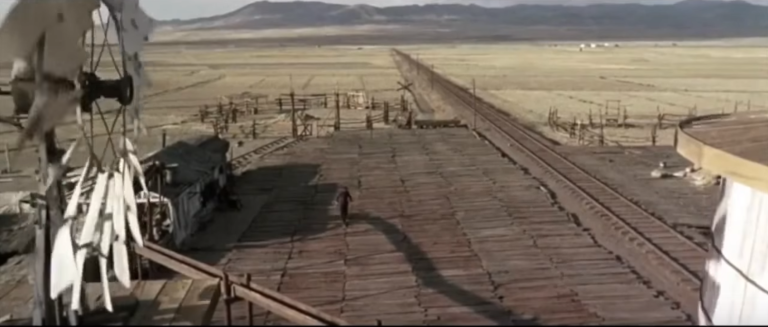
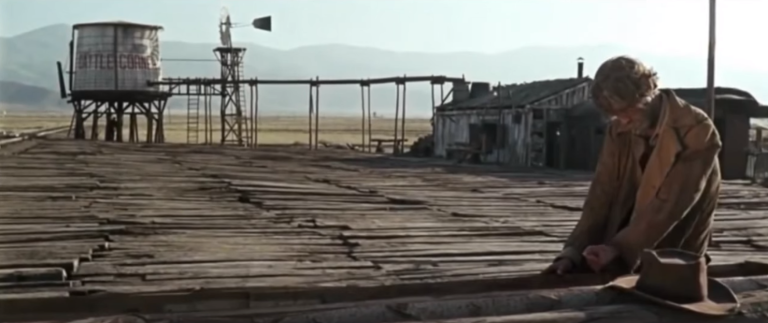
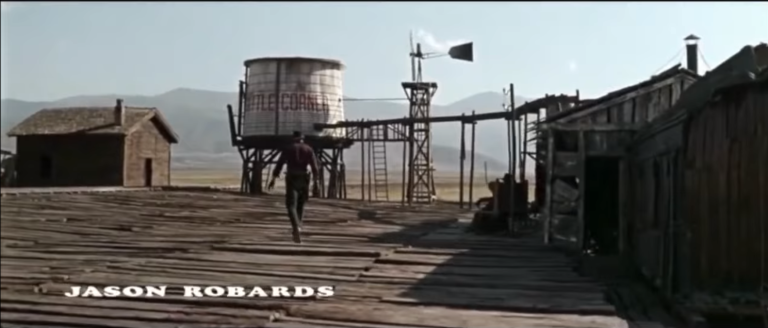
Medium Shot (MS)
The medium shot is the most common in filming. It has been used in many films and television programs and comprises of many different other variants such as the two shot, over the shoulder shots, and even group shots. These are comprised of an actor taken from at least the knees up, but mostly from the waist. Your standard news anchor will usually be framed in such a way on the six o’clock news. There are also a wealth of ways to work these shots for dramatic, thrilling, or exciting scenes.

Tarantino gets the first mention as an example for this type of camera shot in action. Here we get everything we need in the frame while also being close enough to the actors that we can see the emotions on their faces. We can see what they are going to do next. This scene in Pulp Fiction has John Travolta and Samuel L Jackson go to pick up a briefcase from an apartment where they are also going to be sending a very violent message from their boss. After being ambushed by a guy who was hiding in the bathroom (Every single bullet missed), they retaliate in kind.

Camera shots are also a major factor whether the production is live action or animation. Even animated films such as The Incredibles. The shot is typically the upper half of the bodies of the subjects in the frame. A two shot medium shot will have two people.
Medium Close Up (MCU)

The medium close up is our next step as we get closer to our subject. This type of shot is the mid point between a mid shot and a close up. The medium close up shows the subject for the mid chest up. We can see that the subject takes up more of the frame as well. Closer shots like this can capture emotion as Jon Hamm in the above image protrays as he talks to another person, whom in this case is the audience surrogate in the special of Black Mirror. The episode in question uses these shots so well and regularly almost to show that the set pieces aren’t important until they need to be. The whole episode of White Christmas is filled with plot twists that need the audience to be focused on certain characters as the story unfolds.

This shot allows the audience to feel like they are actually apart of the conversation or at least close enough to the subject that it feels like they could be.
Close Up (CU)
With the close up we get even closer. At this stage we are closely framing the subject letting them fill the frame. The use of this shot can be really used to show the intense emotions on the faces of our actors and actresses, we can see if they are sad or happy, we can see the intense emotions play across the faces of the characters filling the frame completely.

In Die Hard the close up is used to put the audience in the same situation as the protagonist John McClain when he is moving through the ventilation system. Its the perfect type of shot for this situation. Another example of how the close up can be utilized properly is in the academy award winning Silence or the Lambs as Hannibal Lector makes an impression on us the audience.

Extreme Close Up (ECU)
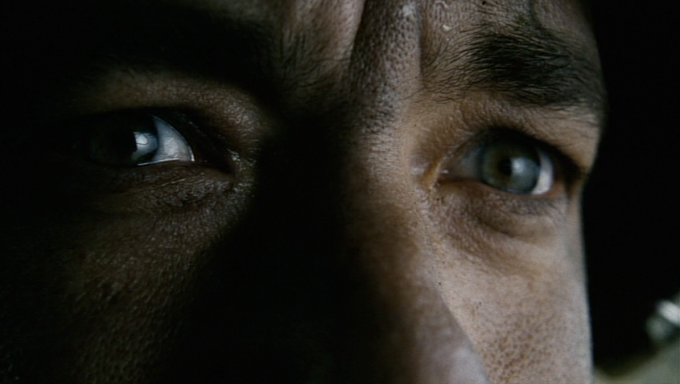
Steven Spielberg makes use of the extreme close up throughout his world war II epic Saving Private Ryan, forgoing standard long establishing shots in favor of extreme close ups acknowledging that the movie is about the characters, and the bravery and fear that they faced in life threatening situations. The extreme close up is all about this. Often emphasising a particular part of a person, be it the hands or the eyes. Other shots like the cut in/away use extreme close ups to focus on an important item in a plot.

High Angle (HA)
A high angle shot is self explanitory, it looks down at the focus point from a high angle. Often this can lead to the focus point being lost but it can also invoke a range of moods when applied correctly. Often at times the subject can look vunerable as the camera angles down at them showing them exposed and in the example below Andy Dufresne in The Shawshank Redemption is exposed to the elements as well. This can lead to the shot itself being more dramatic.

Low Angle (LA)
The opposite of the High Angle shot is the Low Angle shot. Here we are looking up at the world from a less elevated position. Low Angle shots are amazing at making the audience feel small in respect to the other elements in the frame and often puts the audience in the point of view of whatever is looking up.

One of the most successful uses of the Low Angle shot is also the Trunk shot, where we the audience are angled looking out of the truck of a car. Quinton Tarantino loves placing these shots into his movies and you can find a whole load of them throughout his films. If a trunk is involved you can be sure that Tarantino is going to throw in a low angle shot for cinematic effect. If you want to ask why he does this, it can be answered twice. Firstly it follows the traditional low angle purpose of making the audience feel small compared to the elevated actors placed in the scene but also secondly because it adds to the audiences curiosity. What are the characters looking down at?

Tarantino used these moments to add to the audiences curiosity and even though clearly in the next shot we’ll be shown what exactly they are looking at, the low angle shot adds to the value of the scene. The trunk shot in Pulp fiction is used to conceal the weapons the characters carry, in reservoir Dogs it is a Kidnapped cop, and in Jackie Brown it is Chris Tucker after he is coaxed into getting in to the trunk.



figure13 – Tarantino Truck Shots, YouTube, 2012
figure13 – Tarantino Truck Shots, YouTube, 2012
In Inglorious Bastards Taratino done a several POV’s using the Low Angle shot as well, presumably because he did not have a trunk handy.
Canted Angle (CA)
The Canted Angle is a little bit more different than the more common shot types we have covered. They can be used in several ways and to mean several different things. Sometimes called the Dutch angle, this shot type is all about adjusting the horizontal line of the shot so that it is more than just a little bit unusual. It can be completely dis-proportioned when used with other frames within the film and is used when characters are in otherworldly situations that can often defy the laws of physics. It is used to simulate no gravity, or gravity reversal and can also be used to show when a character is sick, drunk, or off their heads on drugs. The uneasiness and queasiness of the angle allows us to feel the way the characters in the scene feel. We can feel when something abnormal is happening. Films like 2001: A Space Odyssey and Gravity, make use of this. Horrors like The Blair Witch Project and Paranormal activity also do this with their ‘Found Footage’ films.
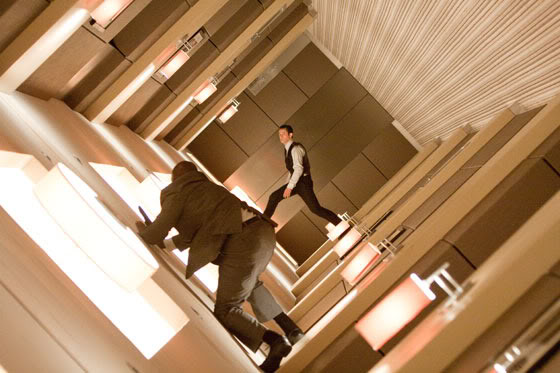
Our example comes from Christopher Nolan’s Inception as Joseph Gordon-Levitt has to fight in a rotating corridor and bedroom using only practical effects. The constantly spinning corridor allowed for Nolan to pick and choose plenty of Canted Angle shots to fill this amazing scene. The video below shows how they made the scene possible.
Overhead Shot (‘Birds Eye’ view, Raised, or Elevated Shot)
The overhead shot could also be seen as a high angle shot but when you fuse this with the Extreme Long Shot, or Long Wide Shot you can create movie magic. This is amazing for establishing shots but it also can be used to showcase drama, action, and background interactions. This can really give a scene a good sense of realism as these shots take a lot of effort to get right as they can involve a lot of moving parts all working together with the focus points.
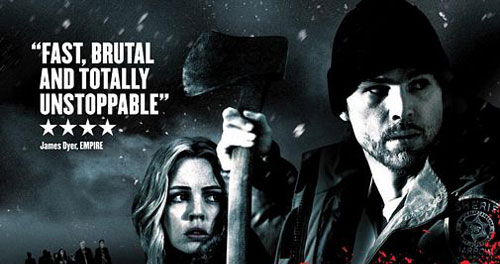
A great example of this in used in the movie 30 Days of Night. While the film is mediocre at best it does however sport one of the most creative uses of this kind of camera shot. Taking place in Alaska where for a month no sunlight touches a sheriff and townsfolk hide from a band of vampires who attack the town. The shot in question takes place when the story requires the sheriff to run through the town to get to a safe house while people are ripped to shreds around him. Films are quite often pushed for time, with lengthy sequences that linger in the second act, a scene like this could ruin the pacing of the film, unless it is done right. However the director David Slade uses the Overhead Shot wonderfully to capture all the action using only 20 seconds of film time.
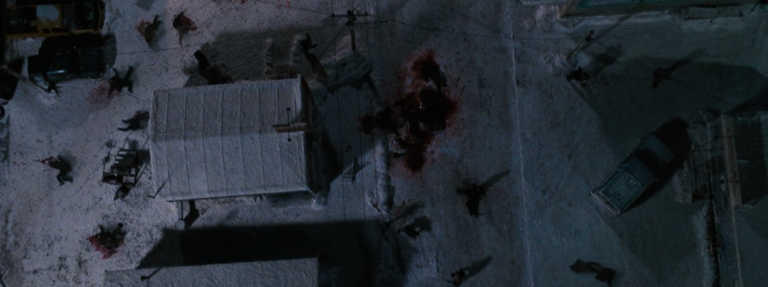
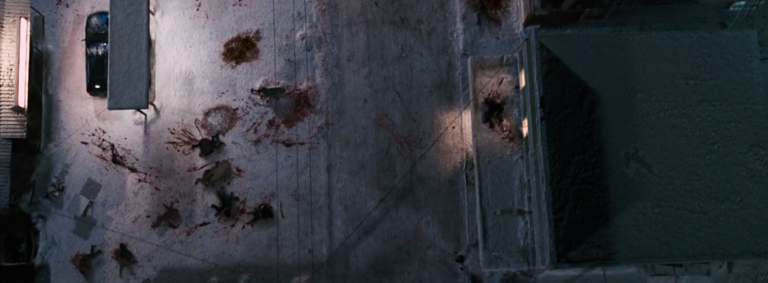
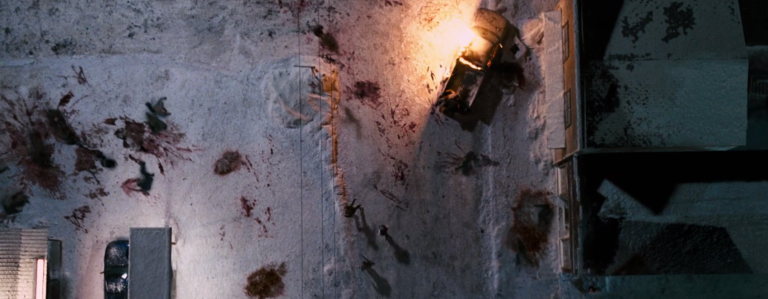
This makes the rest of the scene flow and allows for the audience to establish what the town actually looks like from above. The whole scene is around 4 minutes long but this one shot is the one that makes it one of the best scenes in the whole film.
Over the Shoulder Shot A.K.A. The Two Shot
Over the shoulder shots are used in everything. If you wanted an example you could look at almost any film or television show. If at least two characters are involved and at least one conversation you can bet that an over the shoulder shot will be used at some stage. It isn’t just conversations that make use of over the shoulder shots however. We can see them in scenes with only one character as we see over their shoulder at what they are looking at, or perhaps even into a mirror.
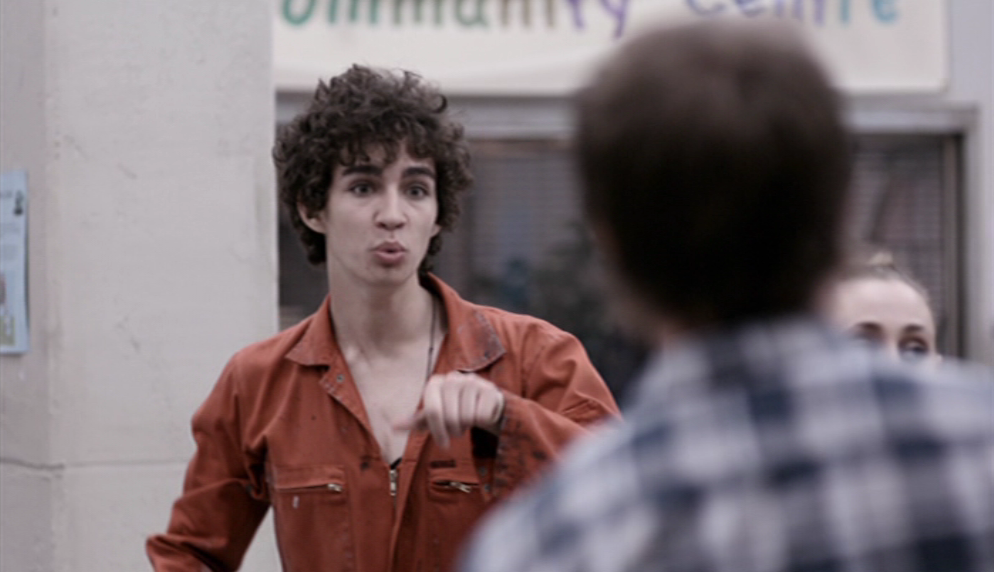
With conversations the over the shoulder shot much like the medium close up, allows us to engage in the conversation as the character seems to directly talk to us even if they are talking to another character. Whether it be police interrogations or heartfelt monologues, the over the shoulder shot continues to deliver. Fuse this with a Noddy Shot (Reaction Shot) from the opposite angle and you’ve got gold.
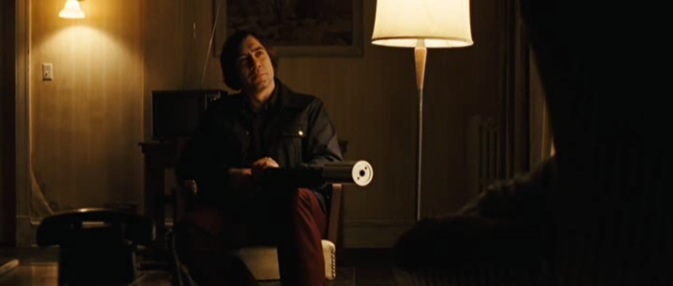
Tracking Shot
The tracking shot is a little bit different, its usually more of a sequence of shots than an individual one. The whole point of the tracking shot is to keep focus on an individual or object as it moves throughout the world. Creatively this can be done so well. The likes of Jackie Brown does this over the opening titles that lasts for three and a half minutes.
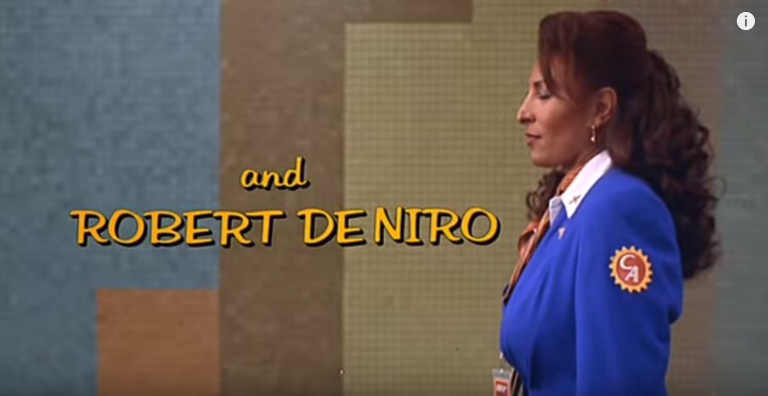
Point of View (P.O.V.)
Point of View shots take the perspective of one of the characters in the scene and frames everything they can see within the shot. It can be used to show how they are feeling or how they perceive reality literally from their point of view. Comedy series Peep Show do this very well.


But for our main example we will be looking at the film ‘Hardcore Henry’. Hardcore Henry began its life as a series of short music videos for the band ‘Biting Elbows’ which the director and writer Ilya Naishuller had involvement with. These two videos involved actions sequences all taken from the first person perspective. With this concept in place Naishuller was able to pull in Sharlto Copley who loved working on small independent films like District 9, that ended up becoming a blockbuster. The film in its entirety is filmed from the perspective of the protagonist in first person view and has been compared to how a first person shooter game would unfold. The film would even manage to pull in Tim Roth.




The film was made by creating custom rigs that would be fitted on the stunt man who would be playing Henry and the special effects were created using the freeware software Blender pushing the limitations of what the software could actually do. The whole film is littered with amazing cinematography and is a masterpiece for what they were trying to achieve. The scene flow into one another often these sequences being shot in one take because there would never be a change in shot. The effort and co-ordination used to create the film is remarkable and is definitely a must watch even if it doesn’t seem like your cup of tea just for the experience.
Framing
Its all about how shots are framed that makes us look into all these different shot types. Why use one shot type over another? Its all about the audience and the viewer. You want the shots you use to be the most effective and to place the audience into the thick of whatever they are looking at or watching. Directors and Photographers will pick and choose and cut what is needed in order to convey a message or to signify what is important in a scene. In Inception shots are used to skew reality working with camera trickery to pull together impossible looking shots.
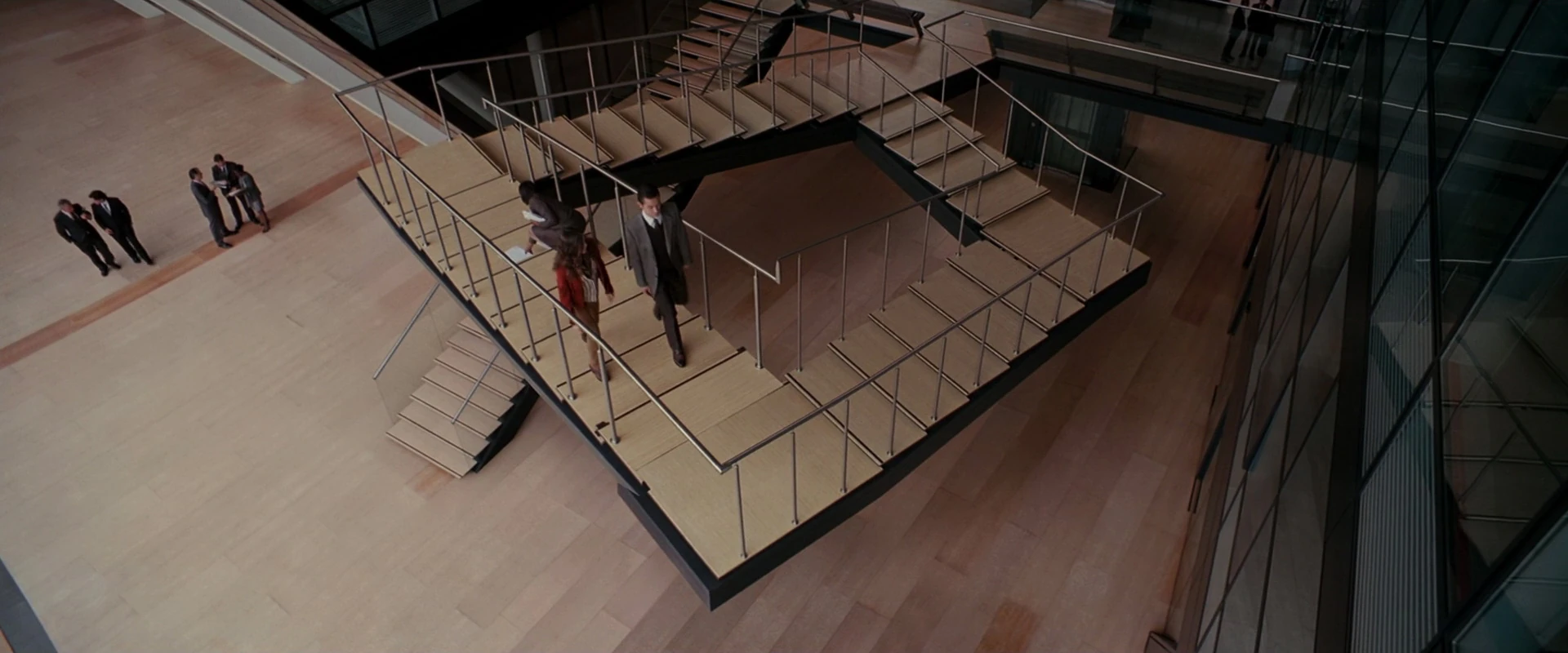
Without the right kind of shot the words the characters are speaking or trying to explain are meaningless in such a visual form of media. In a book our minds can go wild but in a film we can only see what the Director shows us even if they sometimes subvert it as in No Country for Old Men but even that itself is a statement to the audience, that that is not what is important. The missing heist in Resivior Dogs is another prime example of this. If it doesnt add anything to the narrative then it doesnt need to be shown.
References
Figure1 -Tom Antos Films. 2017. The Cinematography of “Sicario” – Tom Antos Films. [ONLINE] Available at: http://tomantosfilms.com/10130/cinematography-sicario/. [Accessed 16 January 2017].
Figure2 – The Sound of Music video song. 2017. The Sound of Music video song. [ONLINE] Available at: http://www.cornel1801.com/videosong/Sound_of_Music/moviesong.html. [Accessed 16 January 2017].
Figure3 – Roger Ebert. 1969. once upon a time in the west. [ONLINE] Available at: http://www.rogerebert.com/reviews/once-upon-a-time-in-the-west-1969. [Accessed 16 January 2017].
Figure4 – nyfa.com. 2015. 12 of the most popular shots. [ONLINE] Available at: https://www.nyfa.edu/student-resources/12-most-popular-camera-shots-actors-should-know/. [Accessed 16 January 2017]
Figure5 – floobynooby.blogspot.uk. 2013. cinematography of the incredibles. [ONLINE] Available at: http://floobynooby.blogspot.co.uk/2013/12/the-cinematography-of-incredibles-part-1.html. [Accessed 16 January 2017].
Figure6&7 – Phil Brown. 2017. Black Mirror: White Christmas TV Review | CGMagazine. [ONLINE] Available at: http://www.cgmagonline.com/reviews/black-mirror-white-christmas-tv-review/. [Accessed 15 January 2017].
Figure8 – Die Hard – Dec. 1 > Boise Classic Movies . 2017. Die Hard – Dec. 1 > Boise Classic Movies . [ONLINE] Available at: http://boiseclassicmovies.com/deals/die-hard-dec-1/. [Accessed 15 January 2017].
Figure9 – Self Land Publishing. 2017. Hannibal Lecter and Buffallo Bill: Three Qualities of Great Villains | Self Land Publishing. [ONLINE] Available at: https://selfland.wordpress.com/2012/09/18/hannibal-lecter-and-buffallo-bill/. [Accessed 15 January 2017].
Figure10&11 – Wright on Film. 2017. A Mann Among Us – Wright on Film. [ONLINE] Available at: https://wrightonfilm.com/2009/07/09/a-mann-among-us/. [Accessed 15 January 2017].
Figure12 – The Art Of Being Here. 2017. 7 lessons I learned from The Shawshank Redemption – The Art Of Being Here. [ONLINE] Available at: http://theartofbeinghere.net/7-lessons-i-learned-from-the-shawshank-redemption/. [Accessed 15 January 2017].
Figure13 – The Art Of Being Here. 2017. 7 lessons I learned from The Shawshank Redemption – The Art Of Being Here. [ONLINE] Available at: http://theartofbeinghere.net/7-lessons-i-learned-from-the-shawshank-redemption/. [Accessed 15 January 2017].
Figure14-17 – YouTube. 2017. Tarantino: Trunk Shot HD – YouTube. [ONLINE] Available at: https://www.youtube.com/watch?v=V_whQnqwEYk. [Accessed 15 January 2017].
Figure18 – Flicks and Pieces. 2017. Inception (2010), Directed by Christopher Nolan – Flicks and Pieces. [ONLINE] Available at: https://flicksandpieces.com/2014/10/02/10-incredible-shots-from-oscar-winning-cinematographers/ca-0326-inception/. [Accessed 15 January 2017].
Figure19 – 30 Days of Night (2007) movie posters. 2017. 30 Days of Night (2007) movie posters. [ONLINE] Available at: https://www.cinematerial.com/movies/30-days-of-night-i389722. [Accessed 15 January 2017].
Figure20 – Windsor girls school Media. 2017. Camera shots typically used in Thrillers – Windsor girls school Media. [ONLINE] Available at: http://windsorgirls.weebly.com/group-3/camera-shots-typically-used-in-thrillers. [Accessed 15 January 2017].
Figure21 – Movies and Philosophy Now: No Country for Old Men: Meaninglessness and the Reality of Self-Mythology. 2017. Movies and Philosophy Now: No Country for Old Men: Meaninglessness and the Reality of Self-Mythology. [ONLINE] Available at: http://moviesandphilosophynow.blogspot.co.uk/2014/06/no-country-for-old-men-meaninglessness.html. [Accessed 15 January 2017].
Figure22 – YouTube. 2017. Jackie Brown intro – YouTube. [ONLINE] Available at: https://www.youtube.com/watch?v=KKQWn-UBDTo. [Accessed 15 January 2017].
Figure23 – Peep Show (TV Series) – Internet Movie Firearms Database – Guns in Movies, TV and Video Games. 2017. Peep Show (TV Series) – Internet Movie Firearms Database – Guns in Movies, TV and Video Games. [ONLINE] Available at: http://www.imfdb.org/wiki/Peep_Show_(TV_Series). [Accessed 15 January 2017].
Figure24 – Movie Reel. 2017. Hardcore Henry (3/5) – Movie Reel. [ONLINE] Available at: http://moviereel.co.uk/hardcore-henry-35. [Accessed 15 January 2017].
Figure25 – Inception Wiki. 2017. Penrose stairs (dream) | Inception Wiki | Fandom powered by Wikia. [ONLINE] Available at: http://inception.wikia.com/wiki/Penrose_stairs_(dream). [Accessed 15 January 2017].
YouTube. 2017. 1 Brilliant Moment of Tension – YouTube. [ONLINE] Available at: https://www.youtube.com/watch?v=-cEBguJj3dg. [Accessed 15 January 2017].
Camera Shots. 2017. Camera Shots. [ONLINE] Available at: http://www.mediacollege.com/video/shots/. [Accessed 15 January 2017].
VideoEditingSage.com. 2017. Overhead Shot Camera Angle: Give Your Audience the Bird’s-Eye View!. [ONLINE] Available at: http://www.videoeditingsage.com/Overhead-shot-camera-angle.html. [Accessed 15 January 2017].
Ian Freer, illustrations by Olly Gibbs. 2017. The Camera Angles You Need To Know – Empire . [ONLINE] Available at: http://www.empireonline.com/movies/features/film-studies-101-camera-shots-styles/. [Accessed 15 January 2017].
Jacob T. Swinney. 2017. Watch: Jonathan Demme and the Close-Up Shot: A Video Essay | IndieWire. [ONLINE] Available at: http://www.indiewire.com/2015/04/watch-jonathan-demme-and-the-close-up-shot-a-video-essay-132973/. [Accessed 15 January 2017].




